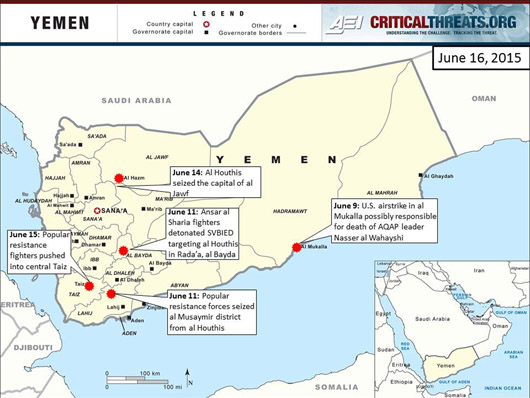Al Qaeda in the Arabian Peninsula (AQAP) confirmed that a U.S. airstrike killed its leader and al Qaeda’s general manager, Nasser al Wahayshi. Wahayshi’s death will probably not significantly affect AQAP’s ongoing operations in Yemen, where it has made significant gains exploiting the fight against the al Houthis in the south and a security vacuum in the east.
AQAP’s operations in Yemen will continue despite the death of AQAP’s leader, Nasser al Wahayshi. AQAP senior member Khaled Batarfi, recently freed from prison, announced that a U.S. airstrike killed AQAP leader and al Qaeda general commander Nasser al Wahayshi. Wahayshi may have been the reported “leading figure” killed in the June 9 U.S. airstrike in al Mukalla, Hadramawt. Batarfi named AQAP military commander Qasim al Raymi as Wahayshi’s successor. Raymi was one of the AQAP leaders featured in AQAP’s January 2009 video announcing the group and has been a key figure in commanding AQAP’s insurgency in Yemen. Recent U.S. airstrikes in Yemen have degraded AQAP’s senior leadership at a rapid rate, killing al Qaeda veteran and former Guantanamo detainee Ibrahim al Rubaish and al Qaeda deputy manager Nasser bin Ali al Ansi.
UN-led political talks in Geneva are unlikely to produce a political settlement or ceasefire agreement as long as the parties refuse to compromise from their initial positions. UN Secretary General Ban Ki-moon opened political talks between the al Houthis and Abdu Rabbu Mansour Hadi’s government in Geneva on June 15, although the al Houthis were not present at the opening due to logistical issues in their delegation’s travel arrangements. Ban called for a two-week humanitarian ceasefire during the Islamic holy month of Ramadan, which begins on June 17. Hadi’s Foreign Minister Riyadh Yassin stated that Hadi’s government would consider a ceasefire if the al Houthis withdraw from major cities like Aden and Taiz and release 6,000 prisoners.
Al Houthi militants are making gains in al Jawf, near the Saudi Arabian border. Al Houthi militants captured al Khanjir military camp in al Ishra’a, al Jawf, near the Saudi Arabian border on June 10. They also seized al Hazm, the capital of al Jawf governorate, on June 14. The al Houthis are likely attempting to make inroads in al Jawf in order to move closer to the Saudi Arabian border and have more territory to use as a bargaining chip at political negotiations.
Anti-al Houthi popular resistance forces have made minor gains against the al Houthis in southern Yemen. Popular resistance fighters claimed on June 11 to have seized al Musaymir district, Lahij, southern Yemen, after intense fighting with the al Houthis. Anti-al Houthi fighters also reportedly advanced toward the center of Taiz city, while southern fighters claimed to have advanced toward Aden International Airport in southern Yemen. The advances, while minor, may signal an inflection point in the current conflict, where battle lines have remained entrenched for months.
AQAP operations will likely continue apace as the group remains focused on battling the al Houthis and cooperating with local tribes to prevent further al Houthi expansion. The impact of Wahayshi’s death will primarily fall on al Qaeda’s global operations and perhaps in AQAP’s external operations, though its bomb maker, Ibrahim al Asiri, remains at large. AQAP will remain within the al Qaeda network despite the Islamic State in Iraq and al Sham’s (ISIS) expansion in Yemen.

